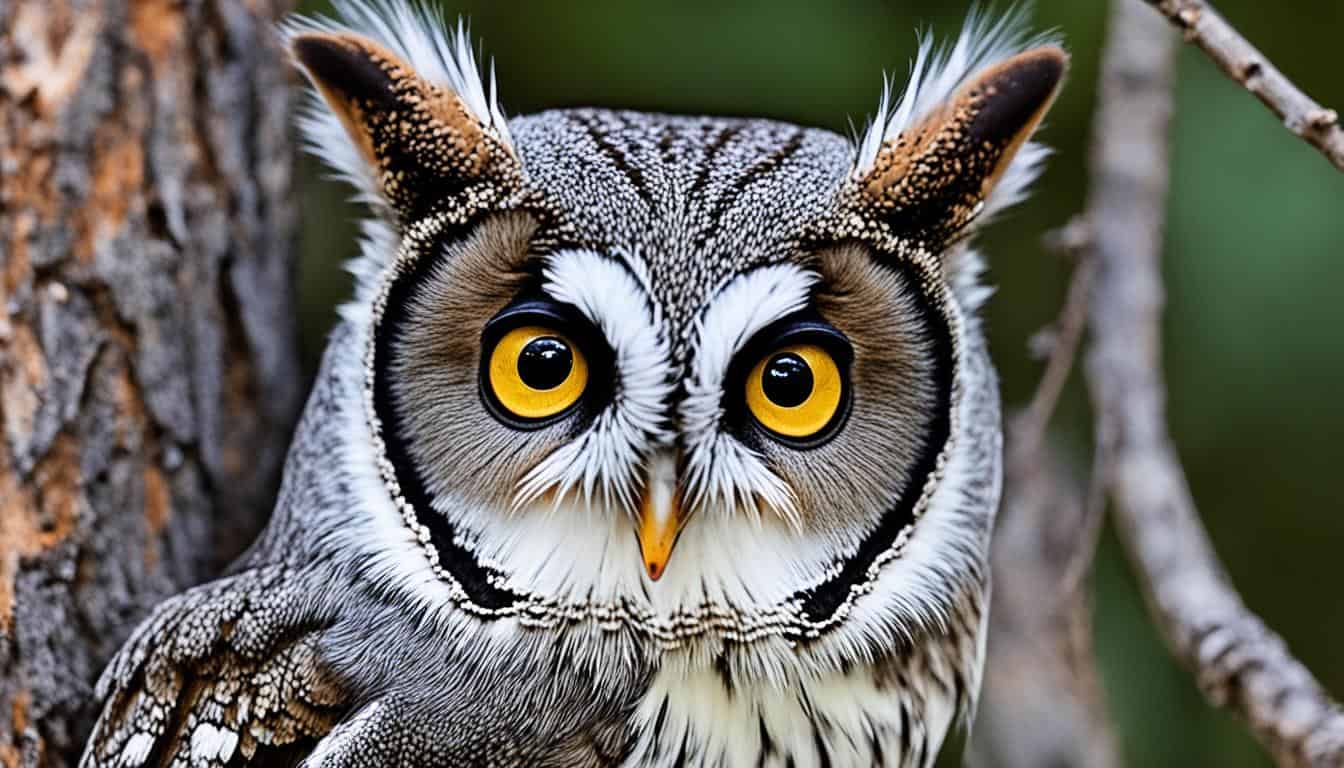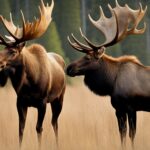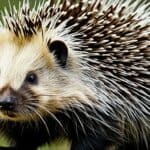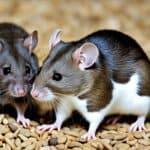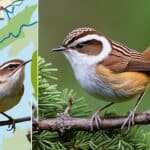Flying squirrels are like hidden gems in the night sky. They’re very different from regular squirrels.
Spotting a flying squirrel isn’t just about seeing them in the dark. They are known for gliding through the night, thanks to their special skin flap. They have soft, grayish-brown fur and big, shiny eyes which help them see well in low light.
They weigh between 4 and 6.5 ounces and can span up to 12 inches long, tail included. This makes them perfect for flying around far distances.
Flying squirrels make soft sounds when they’re alert to danger. Knowing about these features can help you admire them more.
Understanding Flying Squirrel Appearance
Spotting a flying squirrel means noticing special features. Their color, fur, and size show us what they look like. This helps in knowing how they look different from other squirrels.
Body Color and Patterns
Flying squirrels have gray-brown fur. Their sides are darker, and their bellies are lighter. This color mix helps them hide in trees. It’s an important part of who they are and how they survive.
Fur Texture
Flying squirrels have soft, thick fur. This helps keep them warm at night. It also makes their flying smooth. Their fur is more than just looks; it’s part of what makes them special.
Size and Weight
These squirrels are small, usually 4 to 5 inches long. They weigh between 6 to 10 ounces. Their big, bushy tails make up a lot of their length. The tail helps them glide in the air.
Knowing all these details makes spotting flying squirrels easier. It’s good to keep an eye out for them at night. Then you can see them flying around in the dark.
| Feature | Description |
|---|---|
| Body Color | Gray-brown with darker sides and a lighter underbelly |
| Fur Texture | Soft and thick, providing insulation |
| Size | Head and body length: 4-5 inches |
| Weight | Typically between 6-10 ounces |
| Tail | Bushy, aids in gliding |
How Flying Squirrels Glide
Flying squirrels have a unique way to glide smoothly through the air. They use a special membrane called the patagium. This lets them move between trees with impressive grace.
Role of the Patagium
The patagium is a stretchy membrane from their wrists to ankles. This turns their limbs into wings for gliding, not true flying. It works like a parachute, slowing their fall and making their flight controlled.
Using the Tail for Steering
The flying squirrel’s tail helps them steer. It’s like a boat rudder in the sky. This steering tail lets them avoid obstacles and land safely.
Distances Covered in a Glide
Flying squirrels glide long distances. They can cover up to 100 feet in one glide. This helps them move between trees quickly for food or safety.
Unique Facial Features
When talking about flying squirrels, their faces often steal the show. They have big, scooped-out eyes that catch your attention right away. These eyes are super useful at night, helping the squirrels see in the dark better. This ability lets them move around easily when light is scarce.
Flying squirrels’ big eyes are not just for looks; they help them see better in dim light. This gives them a distinctive look compared to other squirrels. This feature is essential for their nighttime adventures and makes it easier for us to spot them.
Besides their eyes, flying squirrels have a special soft fur around their faces. This fuzzy part adds even more to their unique look. It’s like a secret code that helps us tell them apart from their relatives just by looking at them.
These special facial features are a big help in the wild. Their excellent night vision is perfect for finding food and avoiding danger. Plus, looking different helps researchers and nature lovers find and admire these unique creatures.
Spotting a Flying Squirrel in the Wild
Seeing a flying squirrel in the wild is thrilling, especially when you know where and when to look. By learning about their homes and behavior, you boost your chances of seeing them.
Best Times for Observation
Flying squirrels are active at night, so that’s your best time to see them. At dusk, watch for them coming out of their homes. They glide from tree to tree, looking for food.
Habitats and Nesting Sites
Flying squirrels like to live in forests with many trees. They make their homes in old woodpecker nests or build nests with leaves and twigs. These forests are excellent places to find them.

Behavioral Cues
Watching a flying squirrel’s moves can tell you a lot. Notice how they glide and what makes them hide. They often make small noises when they play at night near people. This can help you guess if they are nearby.
Key Differences: Flying Squirrels vs Other Squirrels
Flying squirrels stand out from their ground-bound relatives in many ways. You can see these differences in how they look, act, and even in the unique sounds they make.
Visual Differences
One clear difference is the patagium, a skin flap for gliding that flying squirrels have. Other squirrels don’t have this feature. Flying squirrels also have big eyes for seeing well in the dark. This is unlike squirrels that are active during the day and have smaller eyes.
Behavioral Differences
Flying squirrels are active at night and like company, living in groups. On the flip side, most other squirrels are solitary and prefer the day. Watching when they’re out tells you a lot about their lifestyle.
Audio Cues
Listening can also reveal which squirrel is out and about. Flying squirrels talk with soft clicks and chirps mostly at night. These sounds aren’t like those of daytime squirrels, which are louder and more diverse. Hearing these unique sounds can be a sign that a flying squirrel is nearby.
By looking at how they look, what they do, and even how they sound, flying squirrels can be told apart from other squirrels with ease.
Flying Squirrel Vocalizations
Flying squirrels make soft chirping or clucking sounds. These sounds are crucial for them to communicate, especially when they feel threatened. Knowing these sounds can help you detect flying squirrels.
They make unique sounds that reveal their presence. This is handy in places where they hide, like attics. Their night sounds stand out, making it easier to know they’re there.
Feeding Habits of Flying Squirrels
Flying squirrels are amazing omnivores. They eat a variety of foods to survive all year round. Their meals change based on the season and where they live.
Diet Composition
Flying squirrel diet is very broad. They eat fruits, seeds, and sometimes small animals. They also enjoy bird eggs, tree sap, flowers, leaves, and more. This mix of foods gives them all their needed nutrients.
Eating Patterns
Flying squirrels like to eat at night. They are really good at hunting for food in the dark. You can tell what they eat by what’s left behind near their homes.
Common Nesting Sites
Flying squirrels pick special spots to build their nests, for safety and comfort. These spots are not always easy to find. They like certain places more than others, even though they can live in different areas.
Tree Cavities and Dreys
In warm seasons, these squirrels make homes in tree holes. They use holes made by woodpeckers or nature in dead trees most of the time. They also make nests called dreys from twigs, leaves, and bark in all kinds of forests. These places keep them safe from danger and bad weather.
Nesting in Human Structures
When it gets cold, flying squirrels might move into buildings to stay warm. Attics are a favorite because they’re cozy and quiet. If they nest in your home, you might see nests or damaged wires.
This can cause problems and they might need to be moved gently. This is so they can find a new home without getting hurt.
FAQ
How do you identify a flying squirrel?
Flying squirrels stand out with their ability to glide. They use a special skin flap called the patagium. They have grayish-brown fur, a white belly, and soft, thick fur. Their eyes are big for night vision. Plus, they have a bushy tail that helps them steer while gliding. Adults are usually 4 to 6.5 ounces and up to 12 inches long.
What are the distinguishing characteristics of flying squirrels?
Flying squirrels have distinct features. They have grayish-brown fur with a white underside. Their eyes are big, ideal for seeing in the dark. They use a skin membrane, the patagium, to glide. Their fur is soft and thick, and they have a fluffy tail. They also have special calls and can glide through the air.
What is the role of the patagium in flying squirrels?
The patagium is a special membrane on a flying squirrel. It stretches from its wrists to its ankles. This membrane lets them glide through the air. It helps with slower, controlled descents over distances up to 100 feet.
How do flying squirrels use their tails when gliding?
Flying squirrels steer with their bushy tails when gliding. The tail helps them keep their balance in the air and control their flight.
How far can flying squirrels glide?
These squirrels are able to glide as far as 150 feet. Gliding helps them move between trees and avoid predators.
What are the key features of a flying squirrel’s appearance?
They have grey-brown fur, white on their belly. A patagium allows them to glide, and big eyes help them see at night. Their bushy tail is important for balance and steering.
When is the best time to observe flying squirrels?
At night is the best time to see flying squirrels. They’re active after sunset, gliding between trees. You might also hear them making unique sounds.
Where do flying squirrels typically nest?
Flying squirrels often nest in trees, in both pine and leafy woods. They make homes from bark and twigs. In cold, they sometimes find shelter in places like attics.
How do flying squirrels differ from other squirrel species?
Flying squirrels are unique because they’re out at night and have big eyes. They glide with a patagium and are quite sociable, living in groups. They also have their own special soft sounds.
What sounds do flying squirrels make?
These squirrels produce low, soft chirps and clicks. They use these sounds when they’re feeling threatened. They’re mainly heard at night.
What do flying squirrels eat?
Flying squirrels eat a mix of things like fruits, nuts, bugs, eggs, and more. They prefer to eat at night. Their diet varies depending on what’s available.
Where can you find evidence of flying squirrels’ presence in human structures?
You might find evidence of flying squirrels in places like attics. Look for signs like nest materials, chewed wires, and sounds at night. This shows they’re busy there.

